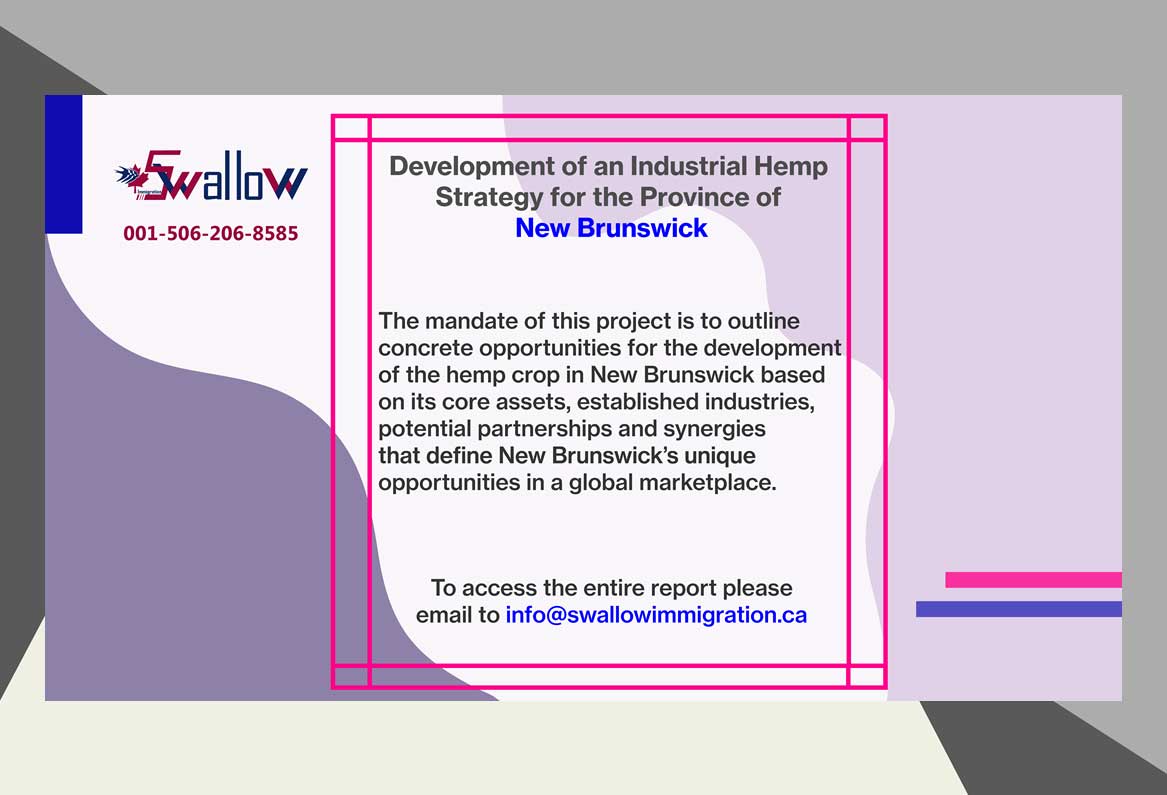
Development of an Industrial Hemp Strategy for the Province of New Brunswick
Presented to:
New Brunswick Department of Agriculture, Aquaculture, and Fisheries
EXECUTIVE SUMMARY
The mandate of this project is to outline concrete opportunities for the development of the hemp crop in New Brunswick based on its core assets, established industries, potential partnerships, and synergies that define New Brunswick’s unique opportunities in a global marketplace.
Market Situation
The first part of the report presents a market scan of the international situation for industrial hemp. In Canada, industrial hemp production has grown steadily since the mid-2000s. In 2017, the area in hemp cultivation and production reached a record of nearly 56,657 ha. Most of the production is concentrated in three provinces: Alberta, Manitoba, and Saskatchewan respectively producing 32 %, 21 %, and 42 % of the country’s hemp. In 2018, the value of Canadian exports of hemp products was $87.5 million compared to a peak of $147.3 million in 2016 and included grain, oil, and cake. This drop is mainly because the South Korean market has replaced Canadian products with Chinese products and an emerging product in some US states.
In the USA, from 1999 onward, a handful of U.S. states have authorized the production of industrial hemp. Until last December, the product had been rendered illegal by federal law for interstate commerce. The Farm Bill adopted in December 2018 is changing this situation by allowing cannabis varieties with low THC (less than 0.3%) to be treated like any other crop. The United States is currently the largest importer of hemp goods in the world. The hemp market generated over $820 million in sales in the U.S. in 2017, up from $680 million in 2016, and is expected to expand to $1.9 billion by 2022. Current CBD consumers purchase highly concentrated tinctures, edibles, and vaporizers with CBD even if the FDA still considers these illegal. The new Farm Bill opens the floodgates to domestic production, economic stimulus, job creation, and opportunities for international trade.
In Europe, the hemp cultivation area reached 46,700 ha in 2017 and France is by far Europe’s biggest producer with just under 17,000 ha in 2016. The production of grain in France in 2016 was 11,500 tons (44% animal feed, 12% oil and 43% food). The fiber production was 25,000 tons (57% pulp & paper, 14% bio-composites, 26% insulation and 3% technical textiles). Shivs/hurds (or hemp wood) production was 43,000 tons (45% horse bedding, 19% garden mulch, 18% other animal bedding, 16% construction, and 2% others) About a dozen companies are processing hemp for food and many are processing fiber in their facilities for a wide variety of applications like automotive and bio-composites.
China is the largest producer of industrial hemp in the world. Their development plan is to grow 1.3 million ha to produce 2 million tons of fiber to supply the country’s textile mills. They have some 500 patents granted on various aspects which is well over half of all patents for hemp worldwide. Australia is entering the market with medicinal cannabis products authorized in November 2016 and the production of industrial hemp for food has been legal since September 2017. India is now starting to explore a hemp revival.
State of the Industry in Canada
In Western Canada, six companies are processing hemp for the food market. The largest one being Manitoba Harvest with sales of US$56 million and recently acquired by Tilray a major Canadian cannabis company. In fiber processing, various projects have been studied or launched but with very limited success. The main processing facility being the Vegreville pilot plant in Alberta and Emerson Plant Distributors in Manitoba making animal bedding material. In other provinces, there are three established processors in the food sector and they are located in Québec (Aliments Trigone, La Minoterie des Anciens, Neptune Wellness Solutions) and two fiber processors (Nature Fibers and Agrofibres).
There are about twenty companies and individual breeders in hemp genetics. Research is needed to improve quality and CBD content.
In addition, obtaining intellectual property is essential to maintain a competitive advantage.
Because the production areas have been limited compared to major crops, the equipment sector has not developed to provide specialized machinery for harvesting and post-harvesting. This will change with the fast-growing expansion of production areas in the US.
In New Brunswick, in 2017, fourteen producers planted a total of 203 hectares of industrial hemp but crop yields in 2017 were extremely variable due to dry conditions and less than optimal crop management. In the fall of 2018, Health Canada changed the regulations and it is now possible to harvest and utilize the entire hemp plant. Consequently, many companies are planning to grow industrial hemp for the extraction of cannabidiol (CBD) from the hemp flower.
Currently, in New Brunswick, five companies or organizations have expressed interest in industrial hemp and four licensed cannabis producers already in place could be part of the hemp sector.
A strong R&D network with at least nine major centers, five key academic institutions, government bodies, and three support organizations (ONB, BIONB, and ACOA), contribute to the development of the New Brunswick hemp industry. A variety of funding programs and the regulatory and policy framework from Health Canada and the Canadian Food Inspection Agency (CFIA) complete the support.
New Brunswick has several important opportunities to use hemp products as ingredients or as a component with the presence of five major industrial sectors. These sectors are the food and beverages industry; the aquaculture industry with two players in feed supply; the poultry sector for feed providing CFIA approval; the forestry sector where hemp fiber finds various applications and the potato industry where hemp could become a rotation crop if technical and agricultural feasibility confirms that option.
Strengths, Weaknesses, Opportunities, and Threats
As outlined in the preceding paragraph, New Brunswick has the advantage of several important strengths: an attractive business environment and the involvement of different support organizations; five hemp processors already in place; a network of about a dozen research centers active in cannabis; four cannabis companies and five major industrial sectors with the potential to use every part of the hemp plant. As a result, considerable expertise has developed in hemp cultivation and use. All of this gives New Brunswick a substantial competitive advantage, which should not be lost.
Strengths, Weaknesses, Opportunities, and Threats
The main weaknesses are a still fragile and limited value chain structure; the need for more research on evaluation and development of seed varieties; the lengthy Health Canada regulatory process and the limited number of registered pesticides. In addition, the lack of a quality assurance program, specifications, and standards are a constraint to the development of the fiber markets. Also, because the industry is very new it has a limited historical background on business and marketing experience and has no provincial industry association. New Brunswick has several market opportunities: strong demand for CBD in the short and medium terms; an established market for grains and hemp oil and a growing fiber market (but at a slow pace in North America). Future quality standards for fiber will give New Brunswick a competitive edge in export markets due to its port infrastructure. The private and public R&D network can develop genetics and intellectual property protection allowing companies to offer customized products and obtain a market advantage in an emerging industry. All the components to organize an efficient and balanced value chain are in place and this will facilitate the development of new high-quality fibers, an organic line of products and create unique branding for the sector to compete internationally.
The development of the hemp industry needs to consider and address threats such as the impact of Government regulations on CBD in each market, the access to the US market under the new US Farm Bill, and the trade regulations between Canada and the US. The competition on genetics will be intense by start-ups and by multinationals. CBD prices will drop because of increased production but that may not happen before the horizon of 2023 -2028. Industrial fiber products will be competing with other natural fibers. Lastly, hemp will have to live with the confusion in public perception about hemp vs marijuana and anticipate how to adapt to climate changes.
All the above leads to the definition of a vision, a mission, and a proposed strategy.
Vision
To build a new industry based on the high-value segments of industrial hemp and contribute to the growth of the New Brunswick economy in the 21st century.
Mission
To develop a vibrant ecosystem around industrial hemp by encouraging collaborations and creating synergies between the growers, the
processors, the R&D network, the supporting agencies, the companies that use hemp as ingredients in their products, and the public.
Proposed Strategy (2019-2023)
The first step to define the proposed strategy was to rank the potential of nine product categories according to two criteria: competitive advantages of New Brunswick and market opportunities evaluated at present and expected for 2023. This ranking identified five “top drivers”: CBD, high purity CBD, high-quality fiber, seeds/genetics, and organic grains. Strategies 1 and 2 are targeting the development of these drivers. The secondary products (grain, fiber, shives, and new cannabinoids) have a potential for additional revenues and two complementary strategies will guide their development as well as provide continued support to the top driver products. These four strategies will be achieved through a set of eight actions shown hereafter, each action is composed of a bundle of activities programmed over the five-year plan period.
Strategy 1: Organize the Industrial Hemp Industry
Action 1: Build the Foundations of the New Brunswick Hemp Industry Cluster with the inclusion of First Nations
Action 2: Create a Hemp Industry Development Fund with Focus on the Top Drivers Including Intellectual Property (IP) Protection
Strategy 2: Support the Viability of a Core Group of Processors
Action 3: Provide Technical Assistance to Growers for Development of the Top Drivers Including Training for Food Safety and Good Agricultural Collection Practices (GACP)
Action 4: Secure Markets for the Top Five Drivers Including Monitoring Competitive Market Intelligence
Strategy 3: Maximize the Use of the Whole Plant
Action 5: Develop an Integrated R&D Program on Fiber for Industrial Uses
Action 6: Evaluate the Feasibility for a Pilot Plant for Fiber Decortication
Action 7: Encourage Cooperation and Initiatives to Minimize Hemp Waste
Strategy 4: Maximize the Economic Benefits for the Province
Action 8: Promote Adoption of Hemp-based Products by New Brunswick Businesses Including Branding of the New Brunswick Hemp Cluster
To access the entire report please email to

